

Tomorrow, Frankenstein’s Creature himself will walk in the Hellboy Universe in a title all his own. Who’d have thought that would ever happen? It’s an incredibly exciting prospect, one that comes with the promise of exploring some of the Hellboy Universe’s biggest mysteries, things like the Hyperboreans, the Hollow Earth, the Victorian secret societies, and of course, the Frankenstein Monster.
Mary Shelley’s Frankenstein; or, The Modern Prometheus has been quite an influence on Hellboy even from the very early days. Frankenstein-like apes and Nazis have always been a part of Mignola’s world, and over the years he’s amassed quite a catalogue of characters and creatures augmented by or given life by science. Whenever they pop up in a story, they add a special dimension to the proceedings, whether it be the over-the-top craziness that accompanies the appearance of some mad scientist’s creation or the beautiful pathos of the child-like Roger.
So let’s get started where these things usually do, all the way back in prehistory, when the human race was still in its infancy…
Spoiler Warning. Most of the stuff I’ll be covering is pretty old, but you’ll want to be up to date with Hellboy and the B.P.R.D.: 1952. There’s also some images taken from previews of ”Frankenstein Underground” #1.
THE CREATURES OF THE LEFT HAND
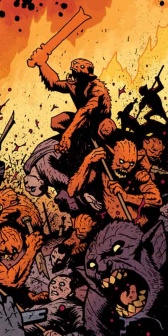
After that… well, that’s a bit vague. Some of them did escape the Hollow Earth, but I don’t know that any of them survived there for very long. In the times of prehistoric humans, we’ve seen corpses of both Hyperborean warriors and the slave race in the ruins of Hyperborean cities. There was definitely some kind of fight between them on the Earth’s surface in some isolated areas at the very least. And we’ve seen in flashbacks that these subterranean people had on occasion ventured from the Hollow Earth, though the were killed by the early humans.
The subterranean people’s failure to survive above ground for any significant period of time didn’t prevent them from enduring in the Hollow Earth though. They dreamed of the day when they would wake the war machines of the Hyperboreans and take the Earth from the humans. And so they remained for hundreds of thousands of years, until they were shaken into action in the early 21st Century by the discovery of a power source for their machines: the pyrokinetic B.P.R.D. agent Elizabeth Sherman.

That’s not to say they weren’t dangerous though. They had wiped out their Hyperborean masters, and they had every intention of doing the same to humanity. When they kidnapped Liz in B.P.R.D.: Hollow Earth, things soon went badly for them and they were defeated, but it had also shown them a glimpse of the power they could possess. Rather than being cowed by their defeat, they were bolstered by it.
Continued belowIn time they came across the frog monsters,2 and through these creatures they found a new way to power their war machines. This led to an attack that destroyed Munich, then later an attack on the newly risen Hyperborean city of Thadrethes. If it hadn’t been for Liz Sherman setting the entire Hollow Earth ablaze and wiping them out in one fell swoop in B.P.R.D.: King of Fear, their next target would have been the entire world, releasing monsters on a scale that even the latest Hell on Earth stories couldn’t rival.
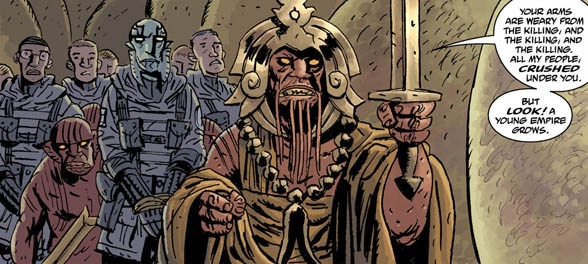
And though these creatures have been wiped out in the modern era of stories, I don’t think we’ve seen the last of them just yet. With the Frankenstein Creature venturing into the Hollow Earth in Frankenstein Underground, I’m quite certain they’ll make some sort of appearance…
THE ALCHEMISTS’ HOMUNCULI
As far as I’m aware, the alchemists were the first humans to attempt to create life by scientific means (which would at best be described as pseudo-scientific in the our own world, but in the Hellboy Universe it is definitely real science with real results, even if the methods still remain largely a mystery). These attempts at life were called homunculi. Most were very crude creations, a sort of mediaeval test-tube baby made from blood and herbs, and incubated in manure.
Nearly all homunculi were small, deformed creatures, but the works of the philosopher and alchemist Edel Mischrasse were works of art. Mischrasse’s works were built on the writings enclosed in Flamma Reconditus (“The Secret Flame”), a Greek translation of an Egyptian text transcribed from the Emerald Tablet, a jewel said to have fallen from the head of Lucifer when he was cast into Hell. The Secret Flame was said to be a record of the true workings of the universal machine, the nature and function of celestial bodies, the transmutation of metals, and the creation and reconstruction of living beings. I’m guessing that last bit was probably pretty helpful in creating homunculi.

With this as his foundation, he created his first masterpiece, a man-sized homunculus. However, this was in 1529, and he feared discovery and prosecution for what he’d done. His fear of being caught eventually led to him poisoning his creation and casting it into the bottom of a well. But the discarded homunculus wanted to live, and over a couple of decades it willed life back into its limbs. In 1566 it escaped from its well and tracked down its creator. By this time Mischrasse has been imprisoned by the Inquisition, and when he saw his old creation, he begged its forgiveness.
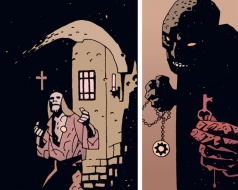
The homunculus learned that Mischrasse had swallowed the key to a box containing many of his notes. Like his creator, the homunculus became consumed with creating life, and having no love for him, he found the quickest way to get the key to those notes was to tear them from Mischrasse’s stomach.
For centuries the homunculus worked in secret, and with the aid of Mischrasse’s notes, he made his own crude homunculi. Just like the young Mischrasse, he considered himself superior to these beings. They were nothing but slaves to him.


Liz was Roger’s second contact, the second person from which his personality was drawn. From Liz he gained much of her own baggage, her Catholic guilt, her own feelings of being unworthy to live, but also her values too. And this wasn’t gained from just living with another like he had with Mischrasse; it had been from absorbing her very life force. I still believe Liz’s inner self helped shape Roger more than another other influence in his life. Later he would gain aspects of his personality from Hellboy, Johann Kraus, Abe Sapien, and Captain Benjamin Daimio, but what he gained from Liz formed his foundation, especially his moral core.
But I’ve spoken before about Roger. In fact, I’ve written an entire Hell Notes article about him, so I should probably stop talking about him before I become too redundant. It was worth restating this though, if only to contrast Roger against his brother, a creature that had developed his personality from being treated like a thing that could be disposed of, from a man that yearned for recognition as superior to his peers and fellow humans, a man that thought himself to be god-like. Roger’s brother absorbed the worst humanity had to offer and it festered within him.
By 1997 Roger’s brother had created his own little workshop of slave homunculi, and was using them to harvest raw material from fresh graves. From the corpses he fashioned his greatest creation, a new body, a colossus through which he could ascend to godhood and dominate the human race. Note the evolution here. This body was not made from blood and herbs, but from corpses. This was not merely mimicking Michrasse’s work. Roger’s brother had done something different, something very much his own.

When Roger’s brother ascended to his new body, he seemed unstoppable despite Hellboy’s best efforts, but there was still a part of him that yearned for acceptance. This made him vulnerable to betrayal by Roger, who saw what a monster his brother had become, and decided to kill him, even though he was potentially the only person that could ever love him.
The level of development these two homunculi had shown was unprecedented and it did not go unnoticed. The Marquis Adoet de Fabre, a collector of all manner of arcane curiosities, had his eye on these two. He was sorry to see Roger’s brother die, but happy that Mischrasse’s true masterpiece remained. The Marquis had his own collection of homunculi, with a space left waiting for a Mischrasse to crown it.

The Marquis de Fabre was so intent on completing his collection, that in B.P.R.D.: The Universal Machine he even went so far as to kidnap Kate Corrigan so that he could extort her for Roger’s remains. That didn’t go very well for him. You don’t mess with Kate Corrigan if you know what’s good for you.
In interviews about the upcoming Frankenstein Underground Mike Mignola has hinted that we will see a familiar character from The Universal Machine. I imagine that the Marquis de Fabre, with his intense interest in collecting a Mischrasse, would also be interested in collecting a Frankenstein…
VICTOR FRANKENSTEIN’S CREATION
The successors of the alchemists were scientists, and it wasn’t long before they too dreamed of giving life to their own creations. Victor Frankenstein was the first to succeed at this monumental task.

But what kind of canon is it? For example, Mignola’s books are about the Hellboy Universe, but the books themselves aren’t a part of it. Kate Corrigan can’t swing by her local comic book store and pick up the latest issue of Hellboy in Hell. But could she go to a book store and pick up Mary Shelley’s novel?
Continued belowThere’s a few ways to look at this. Firstly, it could be that in the Hellboy Universe the events of the novel are strict fact, that events played out exactly as the book says they did. In this version, the novel is of equal standing to Mignola’s books and there is no such book titled Frankenstein in the Hellboy Universe. Secondly, it could be that there is a novel called Frankenstein written by Mary Shelley, which was a recounting of true events as recovered from Captain Robert Walton’s letters and other historical documents. In this case, the novel can be considered mostly canon, with some inaccuracies or blind spots. Thirdly, it could be that Mary Shelley’s novel was a fictionalised account of historical events. In this way the larger events can be considered canon, but the character interactions are fanciful, created by Mary Shelley. And finally, it could be that just like in our world, Frankenstein is considered completely fictitious. In this circumstance, Mary Shelley would have based her story off of rumours and taken creative liberties with her story. The book becomes canon in only its broadest strokes.

Following the popularity of her book came Henry M. Milner’s stage adaptation in 1826, then film adaptations in 1910, 1915, and 1920, and finally the one that seemed to take hold of the public consciousness better than any version before it: James Whale’s film adaptation and its sequel, the ones with Boris Karloff playing the Creature… And from there Frankenstein became a part of the Hellboy Universe’s pop culture.
That last part we can at least be certain of. There are many times in the Hellboy Universe in which Frankenstein is referenced as being as much a part of their pop culture as it is of ours here in the real world. In the 1940s young Hellboy read issues of The Lobster in which the hero fought Nazi-created “Frankensteins.” Like in our own world, the term had become synonymous with corpses brought to life by scientific experimentation. In this month’s issue of Hellboy and the B.P.R.D., when Archie and Hellboy found some corpses stitched together, Archie mentioned that the place looked like some kind of Frankenstein school. And later when Hellboy was attacked by one of these corpse-men, he even called it “Karloff.” So Hellboy has clearly seen a film with Boris Karloff playing Frankenstein’s Creature. There’s no doubt that the everyday people in the Hellboy Universe know the name Frankenstein and what it refers to. The real question is, do the Hellboy Universe’s inhabitants think the Frankenstein Creature is fiction, modern myth, or historical fact?
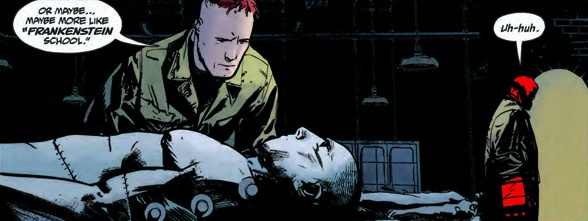
…I hope you aren’t waiting for an answer, because I have no idea. Maybe we’ll find out in Frankenstein Underground.
There are some interesting overlaps between Mary Shelley’s novel and the Hellboy Universe. In Shelley’s novel, the young Victor Frankenstein had an interest in alchemy. Perhaps he read something written by the alchemists that created homunculi. The colossus body created by Roger’s brother certainly shares some similarities with the Frankenstein Creature. Both were made from reanimated corpses and electricity was involved in bringing them to life. In James Whale’s film, lightning brought the Creature to life, just as it had brought Roger to life.
Mary Shelley’s novel was rather ambiguous on the method which gave Frankenstein’s Creature life. She was more concerned with the consequences of giving the Creature life than how that life was given. However, she did make a point of mentioning Victor Frankenstein’s interest in electricity, implying it was somehow connected to the process. Perhaps, like Roger, there is a bit of Vril3 in Frankenstein’s Creature.
Continued below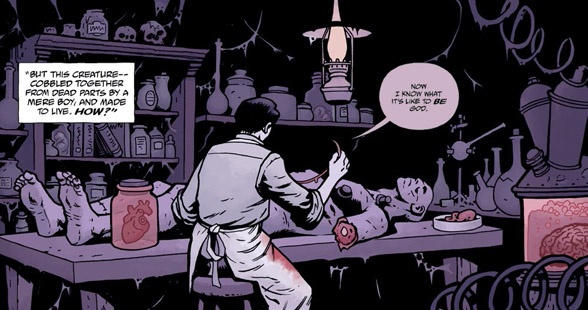
In the conclusion of the novel, the Frankenstein Creature finds his creator dead. The Creature then bemoans his fate, speaking of his misery and isolation. This I find very interesting as it echoes the sentiments of his own creator from earlier in the book. Perhaps, like the homunculi of the alchemists, the Frankenstein Creature took on traits of those around him, and so part of Victor Frankenstein’s identity imprinted on his creation.
Outside of the novel, we know very little about the Creature. However, a preview of Frankenstein Unleashed #1 revealed some of his history between the novel’s ending and his appearance in Hellboy: House of the Living Dead…

When Frankenstein’s Creature was sold, there was no life left in him. Like Roger, the lightning that had given him life had faded away. However, Dr. Kogan found a way to make him live again, and for his amusement, he made him fight Hellboy in House of the Living Dead. But the Creature had not been as completely cowed as Dr. Kogan thought. When he was ordered to kill Hellboy, he hesitated, then turned instead on Dr. Kogan and his assistant, and killed them.

Throughout this sequence, the Creature could do little more than groan and grunt. He was like the Frankenstein Creature in the James Whale films rather than the eloquent character in Mary Shelley’s novel. However, once he was free of Kogan, the Creature seemed to change. I think his mind was waking up again.
After that long and horrible night, Hellboy and the Creature showed up at a bar, and attempted to drown their sorrows in drink. Here, the Frankenstein Creature spoke for the first time, relating to Hellboy a little of his true origins. It wasn’t much, but it was enough to show he was more than just a beast as he had appeared earlier. He’s even more talkative in Frankenstein Underground, much closer to Shelley’s version of the Creature. He seems to be returning to himself, becoming properly alive again.
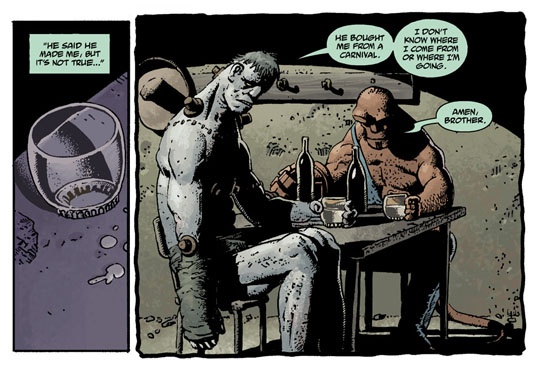
No doubt we shall learn a great deal more about him tomorrow and in the months to follow…
THE CREATIONS OF DR. NIELS WAXMAN

It wasn’t until Lobster Johnson: Get the Lobster that his first run-in with the Lobster was revealed. Set in the October of 1934, nearly three years prior to the events of The Iron Prometheus, Get the Lobster saw New York in disarray when two wrestlers went on a killing spree and the Chief of Police declared war on the vigilante known as the Lobster. They were later found to have been controlled by some machinery installed in their heads. Dr. Waxman was known for his experiments in neuromanipulation, so it didn’t take much for the Lobster to connect the dots.
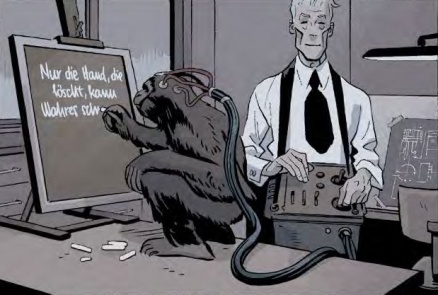
Not only had Waxman found a way to remotely control others, he’d created mechanical prosthetic limbs like the arm he made for Martin Cossaro.

Oh, and Mukali, a modified gorilla. Mechanically modified gorillas have quite a history in Mignola’s comics, but it’s worth noting that Mukali is the first to appear chronologically.

Later, Dr. Waxman and the Lobster were standing on a zeppelin when this happened.

The Lobster survived. More surprisingly, Dr. Waxman survived too. How he survived is a complete and utter mystery. When he showed up again in New York in 1937, he looked completely different, certainly younger, blond instead of grey-haired, but the Lobster still recognised his voice at once. And he was still clearly in the business of mechanical limbs, as he had a goon with him rigged up with specially made arms like lobster’s claws.
Continued belowMost importantly though, he revealed he had been working with the Nazis.
The last time Waxman was seen, he was eaten by giant snakes, so I doubt we’ll seeing him again. However, his legacy seems to live on in the works of his fellow Nazis…
KRIEGAFFEN
Or, translated to English, “war apes.” These critters have shown up several times in the Hellboy Universe, always as the creations of Herman von Klempt. But in light of what we’ve learned about Dr. Waxman in Lobster Johnson: Get the Lobster, it seems likely that the original Kriegaffe was Mukali. And given that Dr. Waxman went on to work for the Nazis, it seems highly likely that he and Herman von Klempt worked together, or at least were familiar with each other’s work. And not only had Waxman created a cyborg ape for combat, he’d also altered at least one ape so that it was able to write in German.
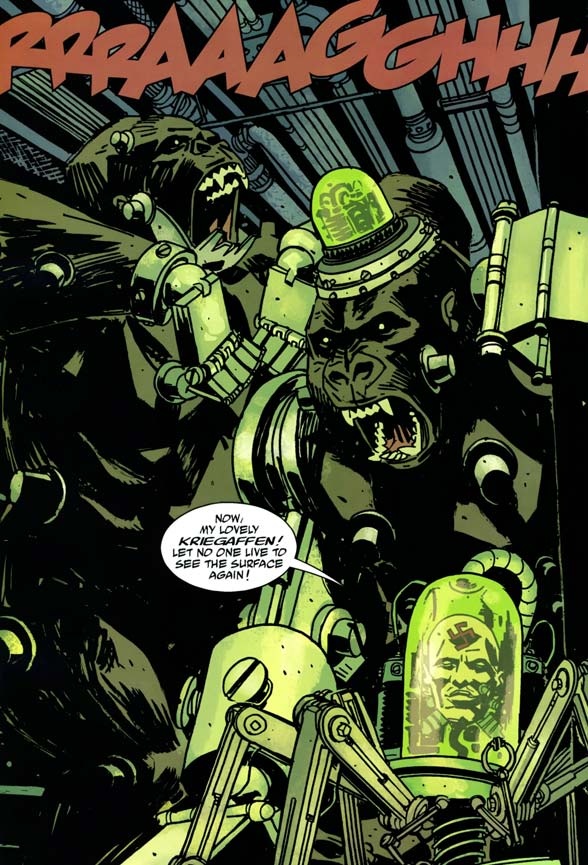

Apes with artificially boosted intelligence and cyborg gorillas have appeared a few times in the Hellboy Universe. In B.P.R.D.: 1946, the Bureau for Paranormal Research and Defense discovered a hidden Nazi bunker beneath Berlin where Herman von Klempt had been busy brewing evil. With him he had Dieter, an ape capable of speaking German and operating complex machinery (though still prone to acts of simian exuberance). He also had a pair of Kriegaffen, one of which was clearly stated to be Kriegaffen Number Two. Presumably the other was Number One or Three (I’m guessing Three, because Mukali might count as Number One). Whatever their number, both of them ended up burnt to a crisp.
Of course, if you’ve read Hellboy and the B.P.R.D.: 1952 #4 then you know that von Klempt has made an appearance. Hardly a surprise given the mechanically altered apes that have been running around. There’s still one more issue to go in this miniseries, but don’t expect von Klempt to get caught, because he was causing trouble in South America right up to the end of the fifties.
In 1959 Hellboy had an encounter with Kriegaffe Number Nine, also known as Brutus. Brutus had been kidnapping peasant girls for von Klempt’s experiments. This particular Kriegaffe was more sophisticated than those shown in 1946. Brutus was capable of operating fine surgical instruments, and even surprised Hellboy when he showed the capacity to talk… and not just grunting a few words, mind you. It could really talk.

Brutus was blown up along with von Klempt’s lab, though we may not have seen the last of him. I don’t mean to imply that Brutus survived the explosion. On the contrary, I’m pretty sure he’s dead, but this story set in 1959 was only a four-page teaser created to introduce the world to Hellboy back in 1994. Since then Herman von Klempt has become a huge part of the Hellboy Universe, so I suspect this four-page teaser will be expanded and further explored some day when we get to Hellboy and the B.P.R.D.: 1959.
More than forty years after Brutus’ tragic demise, Hellboy met another Kriegaffe, and it was far from an enjoyable experience for either of them. Kriegaffe Number Ten pretty much spent all his time electrocuting Hellboy for kicks… and then the power cut out Hellboy beat the crap out of him. Kriegaffe Number Ten certainly didn’t show the same sophistication as Brutus, but before Hellboy killed him, he did manage to make a plea for help.

Since then, there haven’t been any more augmented apes or Kriegaffen, but that doesn’t mean we’re done with them yet… After all, there’s one more issue of 1952 to go. Maybe one will pop up before it’s over, and if not, there’s still seven years before 1959 in which the Bureau could run into Kriegaffen Numbers Four, Five, Six, Seven, and Eight. Encounters with Kriegaffen have never been the most cerebral moments of Mike Mignola’s stories, but they’re always lots of fun. And you know what else makes for fun stories?
KARL KROENEN, HERMAN VON KLEMPT, AND THE NAZI CYBORGS
Continued belowI’ve covered Nazis in a previous Hell Notes, so excuse me if I barrel through this a bit.
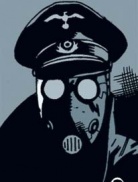
In 1936 a laboratory explosion nearly killed von Klempt, but the members of the Nazi Sonnenrad Society, including Kroenen (and probably Dr. Waxman), managed to save his head through a mixture of science and magic.

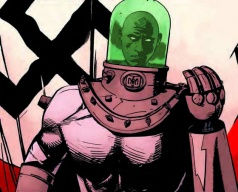
As for Kroenen, he’d been out of action since 1945. He, along with fellow Nazis and Project Ragna Rok members Isla Haupstein and Leopold Kurtz, had travelled to Norway and cryogenically frozen themselves. They awoke in 1994 and picked up work right where they left off.


Kroenen and Kurtz set to work building an army of six hundred and sixty-six soldiers, a symbolic army for the apocalypse. This army is clearly a mix of machinery and flesh. I mean, there’s no mistaking the machinery, and whenever Kroenen is working, he’s always wearing an apron covered in blood.
Things seemed to be going pretty smoothly for a while until Kroenen recovered the head of von Klempt and decided to bring him back to life. A task he succeeded at with little difficulty. Whatever the Nazis did to that head, it really worked. Kroenen seems to be able to switch that thing back on like a light bulb.
However, Leopold didn’t think von Klempt was the best fit for their operation, and attempted to kill him. This led to Kroenen jumping to his friend’s aid and killing Leopold in the confusion. Then later, their whole headquarters got blown up.

However, that mechanical army von Klempt and Kroenen had been working on in the 1930s made an appearance. Long forgotten, they felt cheated of the chance to live, and when Roger the homunculus showed up, they were able to temporarily drain his life force from him. This is interesting because it implies that at one stage these creatures had been switched on, and then like Roger, their life had faded away, but the will to live remained. Whatever Kroenen and von Klempt had created in Hunte Castle, they were machines unlike any other. There even seems to be some similarity between these machines and homunculi and Frankenstein’s Creature.

There were augmented humans at Hunte Castle too… or rather machines with human components. The Nazis had taken humans gifted with the ability to hear the voices of the Ogdru spirits, cut off their heads, and wired them into their radio equipment so they could have a chat to the Ogdru spirits too. I think Hellboy’s reaction to this particular discovery sums it up rather well.

As for Herman von Klempt, he was strutting around Hunte Castle in a brand new mechanical body. That didn’t fool Hellboy for a second though…

Ultimately, von Klempt met his demise when he fell off a cliff and his jar smashed on the rocks. And that’s the end of that.
…Or it would have been if Zinco Industries hadn’t found the head, stuck it in a new jar, and added it to their collection of Nazi memorabilia.

I kid, of course, but I’m still damn curious how they managed to pull this stunt off. Perhaps it’s similar to how Dr. Waxman pulled off his own miraculous survival in Get the Lobster…
However they managed it, now that they were back, they set to work doing what they did best: making their own Frankenstein monsters. In this particular case, the body they were creating was supposed to be a vessel for the soul of Rasputin. A curious detail of this body was its right hand, which shares some similarity to Hellboy’s Right Hand of Doom. It seems they were perhaps attempting to create a replica that could free the Ogdru Jahad from their prison. But whatever they were doing, it didn’t work, and Zinco Industries had to find other means to achieve their ends. Kroenen didn’t exactly handle his failure gracefully…
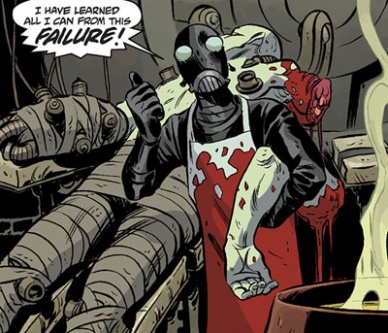
Since then Kroenen and Leopold have become more and more pathetic, and more and more irrelevant. They saw the plans the had been working towards discarded in favour of new plans, and they went from being valued scientists to little more than just a pair of Zinco grunts, performing whatever menial tasks they were given. Leopold grew resentful and angry at this, but Kroenen instead withdrew into himself, seemingly becoming sentimental for times long past. When Zinco Industries decided it would sever all ties with its Nazi past and destroy the collection of memorabilia they had amassed, Kroenen took something when no one was watching. Just a small thing. A head in a jar.
B.P.R.D. Hell on Earth: The Reign of the Black Flame ended with von Klempt held in Kroenen’s arms as he walked away in the light of of dawn. Given the ease that Kroenen has brought von Klempt back to life in the past, I don’t think that head in the jar will be staying dead for long. I dare not think what horrors these two will cook up when they’re reunited. Though I hope it involves a Kriegaffe Number Eleven.

THE OANNES MENAGERIE
OK, I’m going to cheat a little bit here and skip the Oannes Society because I talked a little about those guys in January, I’ll be talking about them a little more in May, and I’ll be talking about them a lot more when I do the second part of my Abe Sapien Hell Notes in June. Obviously they deserve a mention here, (Century-old Victorian dudes living in cyborg bodies. How could they not?) but that’s all they’ll be getting. Just a mention.
Continued below
I’m going to give a little more space to what those Victorian cyborgs created though. They experimented with mingling genes from all manner of creatures. Despite their fearsome appearance, these creatures are actually quite docile.

That’s not to say they couldn’t be used to stir up trouble though. When they were taken into the care of the B.P.R.D., they were kept in a greenhouse habitat inside the Colorado Headquarters. The Bureau allowed Panya to keep one outside the habitat: a pelican crossed with a monkey (henceforth known as the pelimonkey). However, with Panya’s abilities it’s entirely possible for her to take over the mind of one of these creatures and use it to, for example, steal some keys…

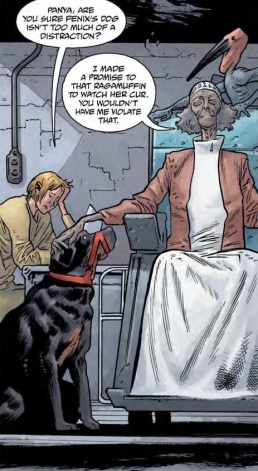
…That’s not to say that’s what Panya did, but it is certainly a possibility. The pelimonkey’s mischief-making seems to have abated these days. It was at one point attacked by Bruiser, Fenix’s dog, so perhaps it’s afraid to stray too far from Panya’s side. There seems to be an uneasy truce in play. Panya was very angry when her pelimonkey was attacked, but she’s since made an effort to put aside her anger and try to get along with Fenix and Bruiser. I’m not convinced this truce will hold though.
And then there’s the other creations made by the Oannes Society Cyborgs: human bodies, made to be spiritual reservoirs for the souls of humanity. They never got to fulfil that purpose though. Abe Sapien hacked up one with a sword, smashed another’s containment tube while it was still in early development, and a third was ripped apart by a were-jaguar.
The fourth and last one is still around though. It was taken by the Zinco corporation and, with the help of Kroenen and Leopold, was made host to the Black Flame. The body is unrecognisable now. A thing once built to save humanity now houses the force that will likely bring humanity to its end.

And I think I’ll leave it on that horrifying note. You’ll see more of the Black Flame in tomorrow’s issue of B.P.R.D., and don’t miss Frankenstein Underground #1. It’s truly something special.
FOOTNOTES
1Hyperboreans: The Hyperboreans were the first race of man. The second was humanity, and the third is supposed to be the frog monsters. They tend to pop up a lot in Hell Notes. I spoke about them in some detail here.
2The alliance: The between the frog monsters and the subterranean race occurred some time after B.P.R.D.: The Black Flame, but wasn’t discovered by the Bureau until B.P.R.D.: The Warning. This was a major game changer in the Plague of Frogs cycle and played a major part in beginning the end of the world. See B.P.R.D. Plague of Frogs – Volume 4 for details.
3Vril: The Secret Flame, the Fire of Heaven. This is the power that was used to fashion the Earth and all life upon it. I also wrote a Hell Notes about it, though it’s kind of old now and the information isn’t quite accurate.
4Project Ragna Rok: Headed by the mad monk, Rasputin, this Nazi project led to Hellboy being summoned to Earth on the 23rd of December, 1944.






